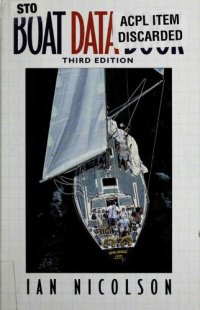
Ebook: Boat Data Book
Author: Ian Nicolson
- Year: 1998
- Publisher: Sheridan House
- Edition: 3
- Language: English
- djvu
Now in its third edition the Boat Data Book has been expanded to include more tables and new data on the latest developments involving anchors, masts, propellers, winches, and the like.
This book is for owners, crew, boatbiiyers, charterers, chandlers, builders, repairers, designers, draughtsmen and students. In fact, for anyone concerned with boats and ships. One of its most valuable uses is saving time and trouble when specifying anything. By simply quoting a page anyone can order equipment without having to look up the correct size and write out lengthy details. An owner can phone a marina or chandler and simply say: "Put a new anchor on my boat. Size as specified in Boat Data Book". Designers can reduce long lists of rigging to: "As detailed in Boat Data Book, page 115, column for yachts between 9 m and 11 m".
Anyone buying a boat can check the standard of its equipment by referring to the lists in this book. There is a widespread practice of fitting boats with totally inadequate anchors, chain, winches and so on. Many second-hand boats offered for sale are found to have inadequate safety gear, and much of what is on board is often out of date. Reference to pages 26 to 35 will show what is needed.
When designing or acquiring a boat it is important to check dimensions of berths, galley top heights and so on. There is a tendency also to save on building costs by fitting furniture which is under-size and as a result inconvenient, besides being uncomfortable to use. Chapter 6 on Design gives many basic dimensions, standard, recommended minimum sizes and so on.
Dimensions are given in metres (or millimetres) as well as feet and inches. Speed is in knots because this is still the universal unit at sea, but there are conversion tables from knots to kilometres per hour and miles per hour.
This book is for owners, crew, boatbiiyers, charterers, chandlers, builders, repairers, designers, draughtsmen and students. In fact, for anyone concerned with boats and ships. One of its most valuable uses is saving time and trouble when specifying anything. By simply quoting a page anyone can order equipment without having to look up the correct size and write out lengthy details. An owner can phone a marina or chandler and simply say: "Put a new anchor on my boat. Size as specified in Boat Data Book". Designers can reduce long lists of rigging to: "As detailed in Boat Data Book, page 115, column for yachts between 9 m and 11 m".
Anyone buying a boat can check the standard of its equipment by referring to the lists in this book. There is a widespread practice of fitting boats with totally inadequate anchors, chain, winches and so on. Many second-hand boats offered for sale are found to have inadequate safety gear, and much of what is on board is often out of date. Reference to pages 26 to 35 will show what is needed.
When designing or acquiring a boat it is important to check dimensions of berths, galley top heights and so on. There is a tendency also to save on building costs by fitting furniture which is under-size and as a result inconvenient, besides being uncomfortable to use. Chapter 6 on Design gives many basic dimensions, standard, recommended minimum sizes and so on.
Dimensions are given in metres (or millimetres) as well as feet and inches. Speed is in knots because this is still the universal unit at sea, but there are conversion tables from knots to kilometres per hour and miles per hour.
Download the book Boat Data Book for free or read online
Continue reading on any device:

Last viewed books
Related books
{related-news}
Comments (0)